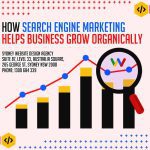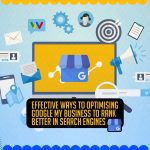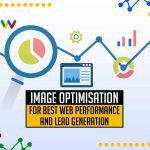Search Engine Marketing and Its Role in Business Growth
Today, online marketing efforts delivers better results and higher revenues than the traditional marketing channels. SEM or Search Engine Marketing is one of the most effective and popular digital marketing tools available today. It helps businesses to connect with their target audience and promote their products or services effectively.
Search engine marketing is a form of online marketing that uses various techniques to improve the visibility of a website or a web page in search engine results pages (SERPs). The main aim of SEM is to attract more visitors to a website or a web page and generate more leads or sales for the business.
Search Engine Marketing SEM can be used to achieve different marketing objectives, such as increasing brand awareness, generating more leads or sales, or improving the visibility of a website or a web page in search engine results pages.
Introduction
In the ever-changing digital world we live in, it’s more important than ever for businesses to have a strong online presence. And one of the most effective ways to do that is through search engine marketing (SEM).
SEM is a broad term that encompasses a variety of techniques and strategies used to increase visibility in search engine results pages (SERPS). This can be done through paid search, which involves purchasing ads on search engines; contextual advertising, which places ads on websites related to the keywords being searched; and organic search rankings, which is the process of improving a website’s visibility and traffic through organic reach.
The goal of SEM is to promote a website’s visibility and encourage more visitors to click through to the site. This helps businesses to generate leads and sales from potential customers who are searching for what they offer online.
Table of Contents
- Best Practices in Building a Search Engine Marketing Campaign
- How Does Search Engine Marketing Work?
- Building Your Search Engine Marketing Campaign
- SEM vs SEO: What’s The Basic Difference
- SEM vs PPC, Which is Best for Your Brand?
- Keyword Research for SEM, Is It Necessary?
- FAQs of Search Engine Marketing
- Personalised SEM Strategy for Your Brand with Sydney Website Design Agency
Best Practices in Building a Search Engine Marketing Campaign

You do not just find new customers with search engine marketing; you bring them to you! Getting in front of prospective consumers who are doing research online, looking for answers to issues you may assist them with, is the key to successful search engine marketing. Here are some of the best practices to help you achieve this.
In Depth Keyword Research and Analysis
You will want to be certain you know what terms your target market is searching for online that are related to your business, product, or service. This will help you determine which keywords to use in your SEM campaign.
Your keyword research should also include an analysis of the competition. You will want to be sure you’re using keywords that aren’t being used excessively by your competitors, as this can impact your campaign’s success.
Developing Compelling Ads and Landing Pages
Once you have determined which keywords to target, you’ll need to create ads that are relevant to those keywords and landing pages that provide a great user experience. Your ads should be compelling and relevant to the keyword they are targeting, as well as the landing page they lead to.
Your landing pages should be designed to convert, with a clear call-to-action and relevant, targeted content. If you are not confident how to create effective ads and landing pages, consider working with a SEM professional who can help you get the most out of your campaign.
Content that is both relevant to your keyword strategy and valuable will help push your website organically to the top of search results. Search engine optimisation, or SEO, is the art and science of making this happen. After you identify which keywords your customers are using, build content around those keywords.
Geo Targeting
Another approach to search engine marketing is by GEO targeting. This means using the position of the location to assist local searchers find you. For example, if our company is located in the city of Parramatta, New South Wales, the search term could be Website Design Agendy near Parramatta, Geo targeting may also be used in sponsored advertising to deliver advertisements only to those within a certain area.
Monitoring and Adjusting Your Campaign
Once your SEM campaign is up and running, it’s important to monitor its performance and make adjustments as needed. You’ll want to keep an eye on your click-through rate, conversion rate and cost-per-click, as well as your overall ROI.
If you see that certain keywords aren’t performing well, or that your ads are being clicked on but not resulting in conversions, you’ll need to introduce changes to your campaign. A SEM professional can help you with this, as well as providing guidance on how to adjust your bid prices and ad spend to get the most out of your budget.
Search engine marketing is a powerful tool that can help you reach new customers and grow your business. By following these best practices, you can ensure that your SEM campaign is successful and delivers the results you are looking for.
How Does Search Engine Marketing Work?

Search engine marketing (SEM) is the practice of using online paid advertising platforms to reach more customers through search engines. SEM includes both paid listings (advertisements that appear at the top or side of a search results page) and organic listings (the web pages that appear because of someone’s search query).
Search engine marketing is the process of placing advertisements on search engines such as Google, Yahoo, or Bing in an effort to boost business online presence. SEM strategies include increasing brand visibility and conversions through website promotion in SERPs.
SEM is a marketing strategy that uses both paid and unpaid techniques to promote online businesses.
Paid advertising on search engines is commonly referred to as pay-per-click (PPC) marketing, which means that businesses only pay when a searcher clicks their ad. The most popular PPC platform is Google Ads (formerly known as Google AdWords), but other popular options include Yahoo! Search Marketing and Microsoft Advertising (formerly known as Bing Ads).
Organic listings are results that appear in SERPs based on their relevancy to the user’s search query. They are not paid for and do not require an advertisement budget. Optimising your website for organic search is commonly referred to as search engine optimisation (SEO).
Why Is Search Engine Marketing Important?
SEMrush is important because it can help businesses improve their online visibility and therefore reach more potential customers. SEMrush does this by helping businesses:
1. Optimise their website for better search engine ranking
2. Place ads on popular search engines
3. Monitor their online reputation
4. Analyse their competitors’ online marketing strategies
5. Generate more leads and sales through effective online marketing
In other words, SEMrush can be a powerful tool to help businesses grow their online presence and reach their target market. Search engine marketing is especially important for small businesses that may not have the resources to invest in other forms of online marketing, such as social media marketing or content marketing.
How Much Does Search Engine Marketing Cost?
The cost of SEM depends on the size of your business and your budget for online marketing. Generally, the larger your business and the more competitive your industry, the higher your SEM budget will need to be.
To get an idea of how much SEM might cost for your business, we recommend using our free keyword research tool to find out how many searches are being made for keywords related to your business each month. Based on this data, you can estimate how much it would cost to place ads on popular search engines and appear in the top results for those keywords.
Building Your Search Engine Marketing Campaign

As the world of online marketing continues to evolve, so too does the field of search engine marketing. SEM, as it is called for short, is the process of using paid and unpaid techniques to improve a website’s visibility and organic search results in SERPs, or search engine results pages.
The goal of any good SEM campaign is to not only improve visibility, but also to increase traffic and ROI, or return on investment. While there are many ways to go about this, some methods are more effective than others. Here are a few tips on how to create an effective SEM campaign:
1. Do your keyword research
This may seem like a no-brainer, but it’s absolutely essential to do your keyword research before launching any SEM campaign. Keyword research will help you determine which terms and phrases are most likely to result in conversions, and it will also give you an insight into what your competition is doing.
There are several tools you can use for keyword research, but a good place to start is Google Ads Keyword Planner. This tool is free to use, and it provides data on both search volume and competition level.
2. Create compelling ads
Once you’ve determined which keywords you want to target, it’s time to start creating ads. Your ad copy should be compelling and relevant to the keywords you’re targeting. It should also include a call to action, such as “Click here to learn more.”
3. Test, test, test
Before you launch your marketing campaign, it’s important to test your ads to ensure they’re effective. You can do this by creating a small test budget and running your ads for a short period of time. Once you have data on click-through rate and conversion rate, you can adjust your ad copy and keywords as needed.
4. Monitor your results
Finally, once you have launched your SEM campaign, it’s critical to monitor your results, so you can make adjustments as needed. Google Analytics is a great free tool that can help you track things like traffic, conversion rate, and average cost per click.
By following these tips, you can create an effective SEM campaign that will help improve your visibility and organic search results. SEM is an ever-changing field, so it’s essential to stay up to date on the latest trends and best practices.
SEM vs SEO: What’s The Basic Difference

Although both search engine optimisation and marketing are ways to make your business more visible in a search engine, there is a key difference between the two: SEO works to get organic traffic from a searcher, while SEM also includes paid methods to bring in traffic.
Paid search results are the ones that show up in a search engine when someone has used a keyword and included “ad” next to the result. These are paid placements, and you pay each time someone clicks on your ad. The price you pay depends on how competitive your industry is and how much you bid for the keywords you want to rank for.
SEO, on the other hand, is all about improving your ranking in the organic search results. These are the non-paid listings that show up when someone searches for something in a search engine. You can improve your SEO by optimising your website and its content for relevant keywords, building high-quality backlinks, and making sure your website loads quickly.
While both SEO and SEM are important for your online presence, which one you prioritise will depend on your business goals. If you’re primarily focused on getting organic traffic, then you should focus on SEO. But if you are looking to bring in more traffic from all channels, then SEM is a good option.
No matter which routes you decide to take, remember that it takes time and effort to see results from either SEO or SEM. Do not expect overnight success; be patient and keep working at it, and you’ll eventually see the fruits of your labour.
SEM vs PPC, Which is Best for Your Brand?

As a business owner or marketing manager, you are always looking for ways to improve your online presence and visibility. You want potential customers to find your website easily, and when they do land on your site, you want them to stay awhile and explore all that you have to offer. Search engine marketing (SEM) is one way to achieve these goals.
SEM encompasses both paid and organic search marketing efforts. Paid SEM, also known as pay-per-click (PPC) advertising, involves placing ads on search engine result pages (SERPs). Organic SEM refers to optimising your website’s content and structure so that search engines will naturally rank it higher in SERPs.
So, which is best for your brand – SEM or PPC? The answer may surprise you.
The Benefits of Paid Search Advertising
Paid search advertising is an effective way to get your website in front of potential customers who are actively searching for products or services like yours. When done correctly, paid ads can be very targeted, appearing only to those searchers who are most likely to convert into customers. And because you only pay when someone clicks on your ad, PPC can be a very cost-effective way to drive traffic to your site.
There are several benefits of paid search advertising:
1. You can get results quickly. Unlike SEO, which can take weeks or even months to show results, paid ads can start driving traffic to your site almost immediately.
2. You have complete control over your budget. With PPC, you can set a daily or monthly budget and never go over it.
3. You can track your results. With PPC, you can see exactly how many people are clicking on your ad and landing on your website. This allows you to make necessary adjustments to ensure that your campaign is as effective as possible.
4. You can target specific keywords. When you use paid advertising, you can specifically target the keywords that you want your ad to appear for. This ensures that only those searchers who are interested in what you have to offer will see your ad.
5: You can bid on competitor’s keywords. If you see that your competitor’s ads are appearing for a particular keyword, you can bid on that keyword yourself. This ensures that your ad appears above your competitor’s, giving you the chance to steal away their potential customers.
The Drawbacks of Paid Search Advertising
Paid search advertising is not without its drawbacks, however. Perhaps the biggest downside is that it can be very competitive and expensive, especially in certain industries. If you are in a highly competitive industry, you may find that the cost per click (CPC) for the keywords you want to target is simply too high for your budget. In addition, even if you are willing to pay a high CPC, there is no guarantee that your ad will actually appear on the SERP.
Another drawback of paid search advertising is that it’s not a long-term solution. Once you stop paying for ads, your traffic will likely drop off sharply. This can be problematic if you are trying to build a sustainable, long-term business.
The Benefits of Organic Search Engine Marketing
Organic SEM is a bit different from paid SEM in that it focuses on optimising your website so that it will rank higher in SERPs without necessarily paying for ads. The goal of organic SEM is to improve your visibility and organic search traffic over time. While this process can take longer to show results than paid advertising, it can provide a more sustainable source of traffic in the long run.
There are several benefits of organic SEM:
1. You can get results without spending any money. With organic SEM, you do not have to pay for ads in order to improve your visibility in SERPs.
2. You can improve your brand awareness. By appearing higher in SERPs, you will be able to get your brand in front of more people, which can help to increase brand awareness and familiarity.
3. You can build trust and credibility. Because organic search results are considered more trustworthy than paid ads, appearing higher in SERPs can help to build trust and credibility with potential customers.
4. You can target specific keywords. Just like with paid SEM, you can target specific keywords with organic SEM in order to ensure that your website is appearing for the right searches.
5. You can improve your click-through rate. Because organic search results are generally considered more trustworthy than paid ads, searchers are more likely to click on them. This can help to increase the traffic coming to your website.
The Drawbacks of Organic Search Engine Marketing
Organic SEM does have its drawbacks, however. Perhaps the biggest downside is that it can take a long time to show results. Unlike paid advertising, which can start driving traffic almost immediately, it can take weeks or even months to see an improvement in your SERP ranking with organic SEM. In addition, organic SEM requires a lot of ongoing work in order to maintain your ranking. If you stop working on optimisation, you may find that your ranking starts to slip.
Another potential drawback of organic SEM is that it can be extremely competitive. In some industries, it can be difficult to rank higher than other websites that are doing similar things. This is especially true if you are in a highly competitive industry.
So, which type of SEM is right for you? The answer depends on your goals and your budget. If you want to drive traffic to your website quickly and do not mind spending money on ads, paid SEM may be the right choice for you. However, if you are looking for a more sustainable source of traffic and are willing to wait a bit longer for results, organic SEM may be a better option.
Both paid, and organic search engine marketing can be beneficial for your business.
Keyword Research for SEM, Is It Necessary?

The first step in any SEM campaign is finding the right keywords. Keyword research can be a time-consuming and tedious task, but it’s absolutely necessary if you want your SEM campaign to be successful. There are many different methods you can use to find the right keywords, but the most important thing is to make sure that they’re relevant to your business and that they have a high search volume.
Once you have found the correct keywords, you need to create ads around them. This is where things can get a bit tricky because you need to make sure that your ads are relevant to the keywords you’re targeting and that they’re also eye-catching and attention-grabbing. The last thing you want is for your ad to be ignored by potential customers.
Search Engine Marketing Frequently Asked Questions
What are the types of search engine marketing?
Search engine marketing is a process of improving the visibility and ranking of a website on search engine results pages (SERPs). SEM can be divided into two main categories: organic and paid.
Organic SEM refers to optimising a website naturally, through content creation and link building, to rank higher on SERPs. Paid SEM, on the other hand, involves paying for ads that appear on SERPs. These can be either pay-per-click (PPC) ads or display ads.
Both organic and paid SEM are important for increasing the online presence of a business. However, organic SEM is often more effective in the long run, as it does not require ongoing payments like paid SEM does. Additionally, organic SEM can help to build trust and credibility with potential customers, as they are more likely to click on a website that appears naturally in search results.
What are the benefits of SEM?
For consumers, SEM provides a convenient way to find information about products and services. Additionally, ads that appear in search results can be helpful in making purchase decisions.
What are the challenges of SEM?
Another challenge of SEM is that it can be difficult to measure the success of a campaign. This is because there are many factors that can impact SERP rankings, such as changes in algorithms. However, there are some tools that can help to track and measure the success of a SEM campaign, such as Google Analytics.
What is search intent and why is it important in search engine marketing campaigns?
Search intent refers to the reason behind a user’s search query on a google search or any other search engine.
Understanding search intent is crucial for search engine marketing campaigns because it helps businesses create relevant search ads that match what users are looking for.
By aligning ads with search intent, you can improve your quality score and achieve better search visibility.
How does the ad auction process work in paid search marketing?
The ad auction is a process that Google uses to determine which ads appear on the search engine results page (SERP) and in what order.
When a user enters a search term, Google looks at the quality score, ad rank, and bid amount for the ad groups in your google ads account.
Ads with higher quality scores and bids are more likely to appear higher on the SERP. This process ensures that the most relevant and high-quality ads are shown to users.
What are ad extensions and how do they improve search advertisements?
Ad extensions are additional pieces of information that can be added to your search advertisements. They can include phone numbers, links to specific pages on your website, or additional text.
Ad extensions can improve the performance of your ad campaigns by making your ads more informative and engaging. They can also increase your ad rank and visibility, leading to better click-through rates and overall search engine rankings.
How do negative keywords impact your SEM campaigns?
Negative keywords are search terms that you exclude from your ad campaigns to prevent your ads from appearing for irrelevant searches. Using negative keywords helps refine your target audience and ensures that your paid advertisements reach the right users.
This practice improves the efficiency of your paid search marketing efforts by reducing wasted ad spend and increasing the likelihood of reaching potential customers.
How can tools like Google Trends and search engine algorithms enhance your online marketing strategy?
Google Trends helps identify popular search terms and emerging trends, allowing you to adjust your digital marketing strategy to target high-demand topics.
Understanding search engine algorithms is also essential for optimising your search engine marketing campaigns. By staying informed about algorithm updates, you can ensure that your ad group and ad extensions are optimised for the best performance.
Together, these tools help you create effective search ads and achieve a successful online marketing strategy.
How do I create an effective digital marketing strategy using Google AdWords?
To create an effective digital marketing strategy using Google AdWords, start by conducting thorough research to identify keywords relevant to your business and target audience. Organise these target keywords into specific ad groups to create focused ad campaigns.
Use the Google Display Network to reach a broader audience and enhance search visibility on the search engine results page (SERP). Regularly monitor and adjust your google ads account to optimise paid advertisements for better performance.
What is the role of SEM campaigns in improving search engine optimization and landing page effectiveness?
SEM campaigns play a crucial role in improving search engine optimization (SEO) and landing page effectiveness by driving targeted traffic through paid advertisements. By optimising ad campaigns with target keywords and leveraging multiple ad groups, businesses can increase their presence on google search and other platforms.
This dual approach of using both SEO and SEM enhances overall search visibility, making it easier for potential customers to find your website through search queries. Combining these sem strategies ensures a comprehensive digital marketing approach that boosts conversions and achieves business goals.
What is search engine marketing and how does it work?
Search engine marketing (SEM) is a digital advertising strategy used to increase the visibility of a website on search engine results pages (SERPs) through paid ads.
It involves bidding on specific keywords relevant to your business. When users enter search queries that match these keywords, your search ads can appear on the google search results page.
The position of these ads is determined by an ad auction, which considers your bid amount and quality score.
How can I create an effective SEM strategy?
To create an effective SEM strategy, start by conducting thorough keyword search to identify the most relevant search terms for your target audience.
Organise these keywords into tightly themed ad group and create compelling ad copy for each ad campaign. Monitor and adjust your paid search marketing efforts regularly to improve your quality score and search engine marketing results.
Incorporate both SEO and SEM into your digital marketing strategy to maximise your online presence.
What are the key benefits of using google ads in my digital marketing efforts?
Using google ads in your digital marketing efforts provides several benefits. It allows you to target specific keywords and reach users with high search intent, increasing the likelihood of conversions.
Google ads also offer detailed analytics to measure the success of your ad campaigns, helping you optimise your search engine marketing work.
Additionally, google ads can complement your SEO efforts, ensuring your website appears prominently in search engine results pages, driving more traffic to your landing page.
Personalised SEM Strategy for Your Brand with Sydney Website Design Agency

SEM can be a complex and daunting topic, especially if you are not familiar with the terminology or strategies involved.
It is hard to know where to start when it comes to SEM, and even harder to know if you’re doing it right. You could waste a lot of time and money on ineffective techniques, or worse, end up block-listed from Google.
Sydney Website Design Agency is here to help. We are experts in SEM and will collaborate with you to create a personalised strategy that meets your brand’s unique needs. We will make sure that you are getting the most out of your advertising budget, and that your website is performing at its best.



















































